-
Posts
1,110 -
Joined
-
Last visited
-
Days Won
1
Content Type
Profiles
Forums
Blogs
Gallery
Events
Store
Posts posted by Hendrik
-
-
... a nice array of devices on a CdG with 1914-1917 reverse : silver palm, bronze palm, bronze star, silver star and gold star

[attachmentid=19389]
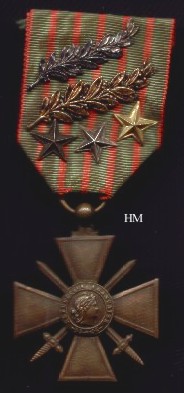
 0
0 -
all members of Frebat who were stationed in Sarajevo were awarded their medal with this bar on it.
Ha, yes, but who awarded these ? Not the French government I think, so .. the local CO ?
A similar event occured in the Belgian Navy where the Navy's Chief of Staff, on a visit to the Belgian ships on patrol during the first Gulf War, awarded a medal with a non-existing Persian Gulf bar to the crews. The medal is quite wrong for this kind of operation and the bar is up till now not officially recognized ... Shows that admirals (at least Belgian ones) do make mistakes !Oh, and there are two versions of it, a French language one and a Flemish type ! Here's the Flemish one :
[attachmentid=19388]
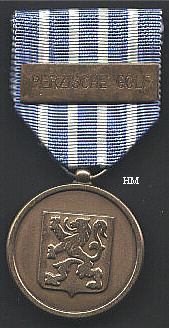
 0
0 -
Hi,
this is to soeone in the 2nd Ligne regiment, he was born in Pays bas (Does that make him Dutch?).
Are these the medals for a front fighter or would he have something different? Is the document official in some way?
Yes Chris, that would mean a Dutchman at birth ...
I rather doubt he saw much front service : no Croix de Guerre, no front bars on the Commemorative Medal...
Not sure about the document being official but I think not ... it was given in "recognition by the grateful nation" but I rather assume veterans' societies (or perhaps even an enterprising printer) were responsible for its creation.
0 -
Any guesses?
The usual UN medal but with a non-official French bar is what I think.
0 -
What I never understood was... the REP also got the Troupe Aeroporte bar, the 3rd infantry regt got the Infantry bar on their medal, but the 2nd infantry regiment never got the infantry bar due to some strange technicality.
I've never got the gist about these bars either : there are the "geographic ones" (the Missions d'Assistance Ext?rieure being one of those) and there are the ones for "specialisation" (e.g. Troupes Aeropor?es, Infanterie, etc.). Whereas it's easy to see what the first ones are for, I have no idea what constitutes the requirements for the "specialisation" bars. Would all members of a unit qualify at the same time or is there a points system for each member to reach before he receives the bar or ... or ... ?
From "Guide Pratique des D?corations Fran?aises Actuelles" :
The 'M?daille de la D?fense Nationale' rewards particularly honourable services rendered by military personnel during their participation in operational activities or the army's operational preparation as well as for interventions on behalf of the population.
The Bronze class is awarded for 6 months of service AND 90 points (???) - Silver class for 5 years and 600 points (and after having received the bronze class min. 2 years before) - Gold class for 10 years and 800 points (silver class min. 2 years earlier).
How does a soldier get these points and would these have something to do with the specialist bars ?
 0
0 -
En 1982, several different models were for sale, from different makers. This is no more the case today, as I believe these casts have been seized by the French State.
The one on the right was one of these "private" medals.
Ch.
Very interesting ! So the government created a monopoly situation for the Paris Mint and favouring the uglier designed medal ... how kind of them

Here's a couple more pictures, type I silver and type II gold classes ...
[attachmentid=19376] [attachmentid=19377]

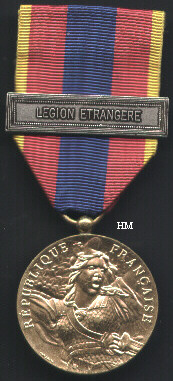

 0
0 -
Same situation, for crosses collectively awarded to units, ships or flights of aircraft.
Christophe,
Now you are confusing me : a CdG award to an army unit would that consist of every unit member receiving a cross ? I thought that's what fourrag?res are for ?
0 -
Hello,
I absolutly disagree with that. These crosses stamped "L/12 J. GODET / u. SOHN / BERLIN 938" are known copies. May be it was not the case when these books from Klietmann or Angolia were written.
jacques
Jacques,
On those I agree with you 100 % but Klietmann does specifically insist on the Godet name on the left cross arm and the "938" on the right cross arm. I've never seen one of those that he describes, only, as in your picture, copies which include the LDO number (which Klietmann doesn't mention at all). It did sound a bit much to have the whole of the Godet name and the city of Berlin on just the one cross arm !

For the sake of completion, here's another copy (sorry for the bad picture) which is silver coloured, has "L/21" on the left and Godet etc. on the bottom cross arm. Hardly visible in the bad picture but there's "938" on the right cross arm ! The lengths those people go to to fake it (and then forgetting about the bronze finish !).
Thanks for your input on this, it's nice to exchange views on such matters.

[attachmentid=19195]

 0
0 -
Somewhat belatedly remembering the Italian Navy has a nice website, I went and checked ...
http://www.marina.difesa.it/storia/Almanacco/Parte08/Navi0836-02.htm
and
http://www.marina.difesa.it/storia/almanacco/parte02/navi0209-02.htm
give descriptions etc. of the two ships concerned !
 They both saw service in WW I.
They both saw service in WW I.And a short search on the Pepe chap resulted in finding him to be a General that served at Marengo in Napoleon's Italian Legion ...
I'm beginning to like those little medals even more now ! Ouch, a new collecting field being born ?
 0
0 -
It is very well detailed. the swasticas of the eagles are cut out (another variant exits with massive ones).
It is unmarked. All the marked ones have to be considered as copy.
Hello Jacques,
I stumbled on this remark in "Deutsche Auszeichnungen" by Dr. K.G. Klietmann :
"in a few cases the manufacturer is mentioned on the reverse. Thus, as an example, on the left cross arm "J. GODET / u. SOHN / BERLIN" and on the right cross arm : "938", meaning the cross is in silver and bronze coloured." - You would disagree with this ?
0 -
Reverse of the "R.N. NAPOLI" one :
[attachmentid=19176]
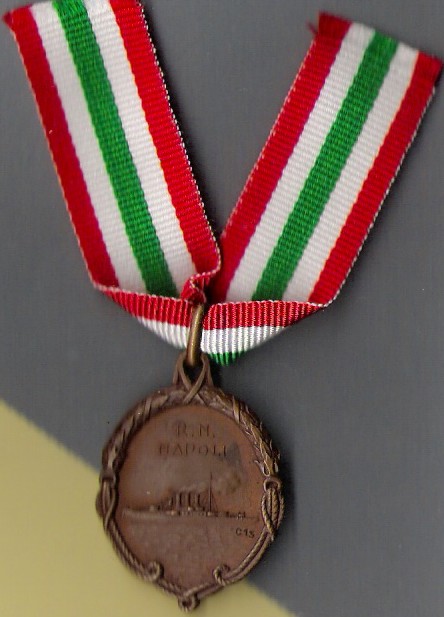
 0
0 -
The second one :
Bronze medal, 33mm high (not including the suspension ring) and 24mm wide.
Obverse : a shield with some drapes - top half of the rim shows a wreath, bottom half of the rim has ropes.
Reverse : top text "R.N. NAPOLI" over what I think is a cruiser with "C13" under its stern. Bottom left, the initials S.J. again.
[attachmentid=19175]

 0
0 -
... and a picture of the reverse ...
[attachmentid=19174]
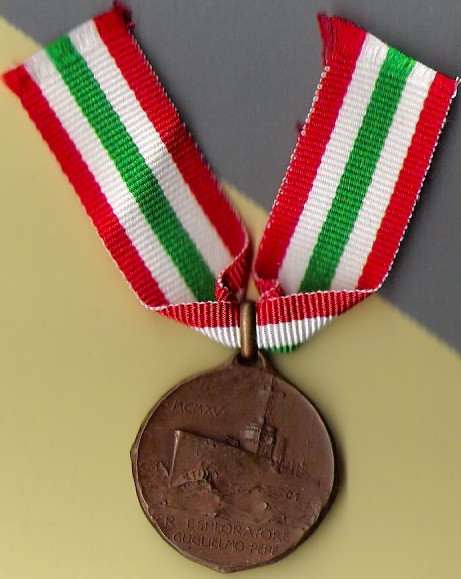
 0
0 -
The number of non-official Italian medals (i.e. medals not awarded by the government but by veterans' or patriotic societies and the like) seems to be quite large. Although some are of very little interest to militaria collectors, others may be hiding an interesting background.
A couple of those arrived in the mail today and I'm posting them here ... Looking forward to any information that club members may have on these.
[attachmentid=19172]
This first one is a bronze medal, 26mm diameter.
Obverse : to the right of the unknown gentleman is the text "Nullum Opus Arduum". At 7 o'clock are the very small initials S.J. which leads me to think this medal was manufacturered by the firm of Johnson in Milano.
Reverse : what appears to me to be a destroyer with "C7" under its stern. Top left is the year "MCMXV" (1915) and in the exergue "R. ESPLORATORE GUGLIELMO PEPE".
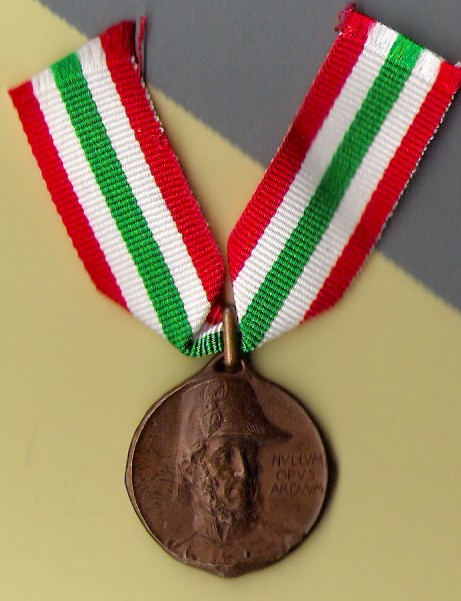
 0
0 -
Hi Gunner 1,
Many thanks indeed for clearing up these points with a wealth of interesting information !

Hendrik
0 -
WWI type with bronze palm and silver (!) lion device replacing 5 bronze lions.
Oops ! I made a mistake here
 : it's only 5 bronze palms that get replaced by a silver one ...
: it's only 5 bronze palms that get replaced by a silver one ...Gilt palm : replacing 5 silver palms - Silver palm replacing 5 bronze palms
Bronze palms are awarded for citations in the Order of the Day of the Army - Gilt, Silver and Bronze lions for resp. citations in the Order of the Day of a Division, a Brigade and a Regiment.
Generally speaking, these citations would involve an act of bravoury but over the years regulations were relaxed and included many other possibilities e.g. good conduct during min. 3 years in the trenches, being invalided out because of severe war wounds, etc.
0 -
Skipping to WW2 ... note the royal cypher on the palm and the reverse : LIIIL with the last 'L' being mirrored on the first (King Leopold III).
[attachmentid=18916]
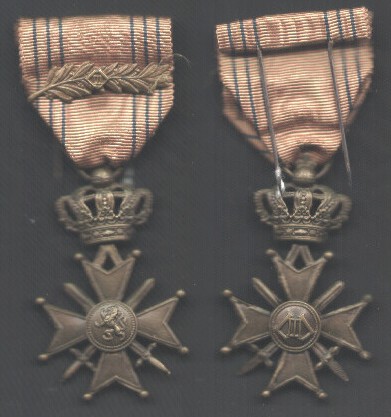
 0
0 -
... and this one just didn't get to the silver lion but got a 2nd palm

[attachmentid=18913]
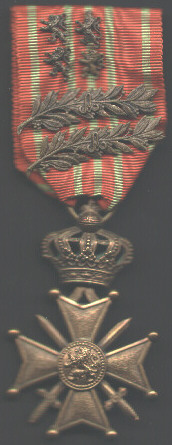
 0
0 -
Here's one with some 'stuff' on its ribbon ... WWI type with bronze palm and silver (!) lion device replacing 5 bronze lions.
[attachmentid=18912]
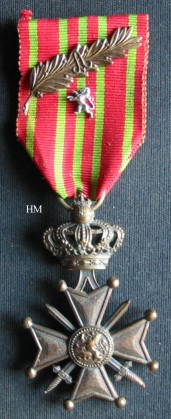
 0
0 -
Good background. On another thread one person asked if the GdG was ever awarded WITHOUT a Star Device? Or is that the minimum they had when awarded. I have yet to see one with just a plain ribbon.
Browsing through some of the older threads here I came across this excellent question which appears to still remain unanswered ...
In my opinion there's at least one instance in which a CdG without palm or star could be awarded : the Legion of Honour and the Military Medal were sometimes awarded with an accompanying CdG. As the the award of the higher decoration would already constitute the proper citation requirement, the CdG would in those cases be on a plain ribbon.
There's also the point of collective awards to be considered : lots of CdG's were 'exchanged' between France and Belgium (and quite possibly with other allied countries) at the time. France would send a number of CdG's to Belgium and merely request a list of names from the Belgium government as to who received them in the end ... I can well imagine there being no ribbon devices on those. Belgium would, courteously
 reply in kind, so one could expect a fair number of Belgian WWI CdG's to turn up without those lovely devices as well.
reply in kind, so one could expect a fair number of Belgian WWI CdG's to turn up without those lovely devices as well.I, for one, would love to hear more on this ...
0 -
I did not think that it was old, but I thought it would have had both languages on it.
Would the swords be an add on by the owner or a dealer trying to enhance the medal? Should I remove them?
The unilingual Flemish box in my opinion merely indicates the manufacturer came from Flanders rather than say Brussels ... being in Flemish only probably makes it 1980's or later rather than earlier but there's no way for me of accurately confirming this.
I'd leave the swords on : manufacturers sometimes use these when they feel the rosette is an obstactle for placing the correct wider swords there ... it needs more ribbon to put the latter on ! Just saving on manufacturing costs I think.
 0
0 -
A cased Golden Palm Leaves with Flemish writing only, would this be for a pre 1950 medal?
I would rather think it's post-1950 and even much later than that ...
0 -
A Knight of the Order. If I am wrong with the levels of the medals would you let me know please. How do you tell which ones are pre or post 1950, does the crown size have any meaning? Why do some have the swords on the medal and some on the ribbon?
Hi Laurence,
You have the pictures in the wrong order : the officer class is the gilt one with the rosette on its ribbon, the knight class is silver/silvered bronze and without the rosette.
As far as I know, there's no way of dating the Crown Order accurately unless accompanying documents referring to the recipient receiving his award are present. The crown size is not really relevant as lots of varieties exist merely because different manufacturers over the course of time have produced these awards.
I seem to spot the possibility of a silver marking on one of the suspension rings but it could be the place where the ring was soldered to close it ... you may need your magnifying glass

I've never seen a crown order with swords on the cross/medal itself. The crossed swords on the ribbon signify an award to a veteran : simple crossed swords for WWI, same but with a small planchet "40-45" for WWII and same but with a small planchet "COREE - KOREA" (or the other way around) for the Korean War. Sorry to say but the ones on yours are non-regulation. The "correct" ones have a broader blade tip (see pics of officer and knight class below). Also to be noted : the crossed swords for the knight class are silver, the ones for officer class or above are gilt.
In case you're wondering : the palm on the ribbon signifies an award for wartime merit or action. The crossed swords would then have been added on the ribbon later, years after the war, when the recipient became entitled to them as a veteran (in the late 1930's I believe).
[attachmentid=18745] [attachmentid=18746]
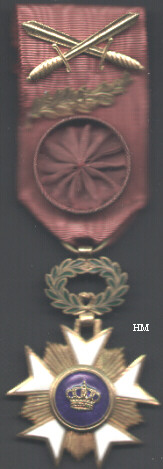
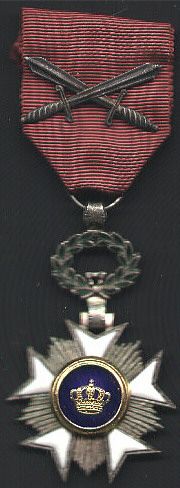

 0
0 -
this came with some WW1 era russian items..could it be from this period?
George
Hi George,
I agree completely with Christophe : the design and quality points to this knight class being from well before the present model. The Order of the Academic Palms was instituted on 17 March 1808. The first insignia (1808-1866) were embroidered and from 1866 to 1955 these became silver (or silver gilt for the Officer class) decorations as the one you have. The design of the post-1955 ones is markedly different.
During the 1866-1955 period there were, of course, many variations being made by several manufacturers. Although having too little documentation at my disposal to verify it, I tend to think the one in your picture dates from considerably before 1955 but also from some time after 1866. It does, therefore, fit in nicely with your timeframe.
0




French Croix de Guerre WWI
in France
Posted
... or you could spruce your CdG up with a fancy ribbon (combination of Military Medal, CdG and Wound Medal ribbons) or have it privately silvered ...
[attachmentid=19391] [attachmentid=19392]